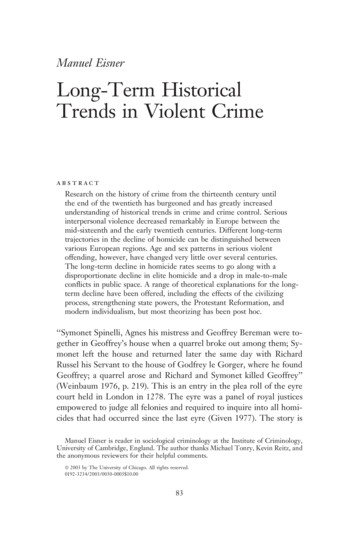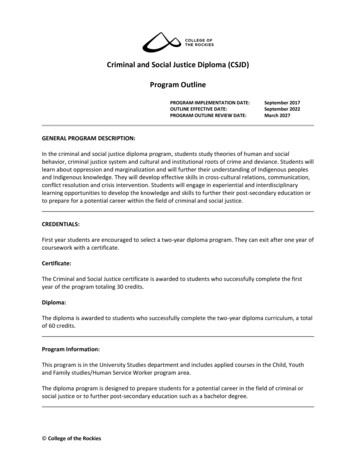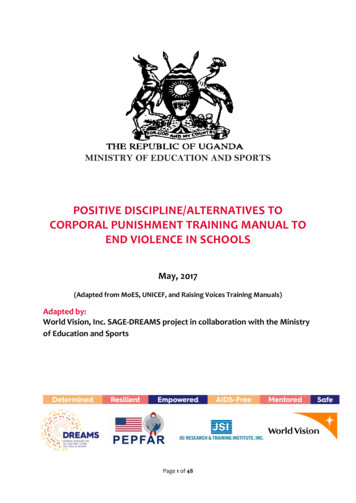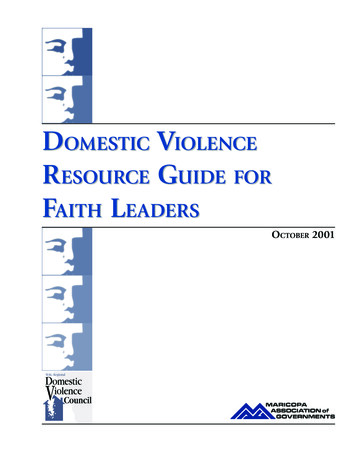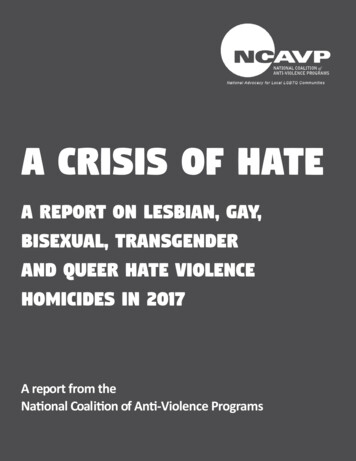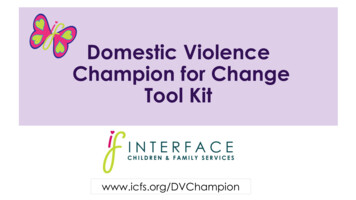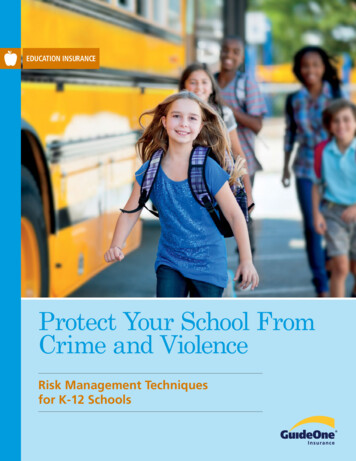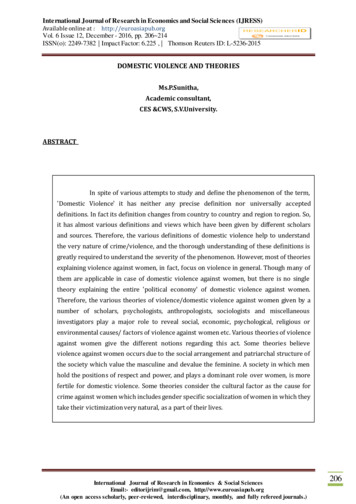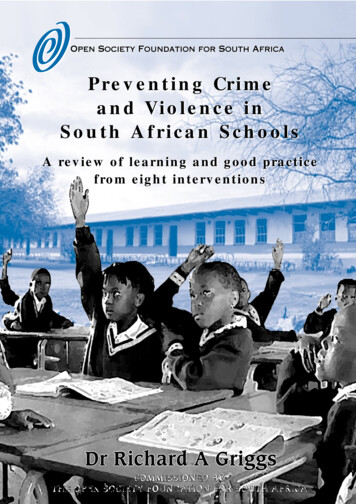
Transcription
Preventing Crimeand Violence inSouth African SchoolsA review of learning and good practicefrom eight interventions
Preventing Crimeand Violence inSouth African SchoolsA review of learning and good practicefrom eight interventionsDr Richard A GriggsSeptember 2002Commissioned by theCriminal Justice Initiative,Open Society Foundation for South AfricaColinton House, Fedsure Oval, 1 Oakdale Road, Newlands 7700,PO Box 23161, Claremont 7735Tel: 27 (021) 683 3489 Fax: 27 (021) 683 3550E-mail: admin@ct.osf.org.za Web: www.osf.org.zaAn association incorporated under Section 21 – No. 95/12103/08
IntroductionThe Criminal Justice Initiative (CJI) at the Open Society Foundation for SouthAfrica is primarily a grant-making programme, with an interest in buildinglocal knowledge and sustainable innovation in the criminal justice system, aswell as in relation to the prevention and reduction of crime. To this end, since1999, the CJI has provided support to civil society organisations undertakinga range of different innovative projects primarily aimed at the prevention orreduction of crime. These have been in three broad categories: local government-focused initiatives, community-focused initiatives and school-basedinitiatives.During this period, the CJI provided support to eight NGOs undertakingschool-based crime or violence prevention initiatives, each adopting its ownunique approaches and strategies to address different kinds of problems beingfaced by South African schools. The idea was to generate local learning andto complement the range of lessons available from abroad, with a view tostrengthening the ability of South African schools to respond to the challengesof crime and violence.In 2001, the CJI contracted researcher Dr Richard Griggs to conduct a reviewof these eight projects with a view to extracting good practice; articulatinglearning that has emerged, and formulating some ideas regarding the elementsof a “best practice” strategy for working in South African schools. It shouldbe noted that this report does not pretend to present an evaluation of theseprojects. The researcher’s findings are based on the documentation producedby each project, on observations and discussions with beneficiary schools andon interviews with the implementers of these projects.From the perspective of the CJI, it is hoped that this, together with other learning emerging out of similar work, can contribute to strengthening the capacity of schools to respond to crime and violence, and provide clear lessons toNGOs that wish to assist in this process.The learning captured in this report would not have been possible without thecreative vision and boundless energy of the people who serve the eightparticipating organisations. The work of each of these individuals is a beaconfor those of us who seek to understand how to navigate the trials of thischanging environment. The staff of the CJI have been privileged to interact2
Acronyms and AbbreviationsCJICriminal Justice InitiativeCPFCommunity Policing ForumCOPESCommunity Psychological EmpowermentServicesCSVRCentre for the Study of Violence andReconciliationELLCEnglish Language, Literacy and CommunicationGBVGender-based ViolenceIPTIndependent Projects TrustLRCLearner Representative CouncilNGONon-governmental OrganisationNWFNew World FoundationOBEOutcomes-based EducationOSF-SAOpen Society Foundation for South AfricaPHPPublic Health ProgrammeSAPSSouth African Police ServicesSGBSchool Governing BodySMILESt Mary’s Interactive Learning ExperienceUCTUniversity of Cape TownUWCUniversity of the Western CapeWCEDWestern Cape Education Department4
Sections 1 through 8 consist of thirteen subsections, including: Introduction The Strategy Geographic Extent of Work Target Group and Exposure Material Content Training Content Monitoring and Evaluation Methods Impact Challenges Ahead Sustainability Key Lessons Learnt (offered by the organisation) Best Practices in terms of Strategy (the reviewer’s analysis)Section 9 collectively analyses all the best practices identified in each section.Best practices are defined as procedures and tactics that can be replicatedby most organisations, irrespective of the precise style of intervention. Suchtactics also increase the chances of a sustainable intervention. In analysis,duplications were eliminated and the underlying element of success in apractice discerned. For instance, the involvement of the South African PoliceServices (SAPS) in school programmes might be seen as one best practicebut the underlying idea is that partnerships with service providers outsidethe school can increase the chances of a successful intervention.In Section 10 recommendations are made for developing an ideal, integratedstrategy for working in schools. Potential targets, strategic components andbest practices extracted from the collective experiences of all the NGOs wererefined through analysis with reference to international reviews of bestpractices. The result was a recommended strategy with accompanyingillustrations and explanations.All the tools described above offered a focus for workshop discussions held atthe end of November 2001 that brought together key stakeholders among thereviewed organisations, along with academics, education officials and otherinterested parties. This workshop further informed the strategy of theCriminal Justice Initiative so Section 11 which describes the feedback fromthe workshop, was added. Generally, the feedback supported the strategybut led to a retraction of a suggestion given in the final recommendationof Section 10 that CJI consider a tender process. Instead a further study,similar to this one, addressing the appropriate and effective partnerships forimplementing the strategy is recommended prior to any consideration of atendering process. This is fully explained in Section 11.6
S e c t i o nO n eS t M a r y ’s I n t e r a c t i v eLearning Experience(SMILE)I n t r o d u c t i o nSt Mary’s Interactive Learning Experience (SMILE) began in KwaZulu-Natalin 1991 when two former teachers with significant experience in developingcoursework materials came together in an effort to improve English teachingand learning skills among Grade 4-7 educators and learners. The initialchallenge was that young black learners in KwaZulu-Natal often failed tocomplete Grade 5 because of poor English language skills. Upon examiningthe problem, SMILE founders Daniela Browne and Lynda Swinbourn considered the need to hold the interest of learners in the subject. Since Englishrequires some medium or vehicle of instruction, they decided that relevantage-appropriate themes that were exciting and well presented would be thekey to success.These English lessons around an interesting theme took place initially at onevenue (St Mary’s Diocesan School for Girls, where SMILE offices are stillsituated today) with young black learners taxied in from surrounding areas.Owing to the success and popularity of the programme, some local principalsapproached the educators to ask whether this system could be brought intoevery classroom. Browne and Swinbourn accepted the challenge and developed their programme around a whole series of age-related themes thatcorrespond with the phase organisers of the English Language, Literacy andCommunication learning area Outcomes-based Education (OBE). Today thereare 20 themes (five themes each for Grades 4-7). SMILE continues to workon new themes and new grades.The programme of training that developed with the learning materials came tobe entitled the ‘Classroom Reinforcement and Teacher Training Programme’.Despite the subsequent expansion of SMILE programmes, projects and areasof operation (now in five provinces) this remains the core work of SMILE.In 1997 SMILE was commissioned to develop material on crime prevention asanother thematic vehicle for learning English skills. This was done based onresearch and consultation. Both learners and educators were consulted andthe main finding was the shocking level of crime and violence to which8
Figure One:The number of communities, schools and learners affected by 1998 and2000-2001 Open Society Foundation Funding to terville47454WCKhayelitsha22002Heidelberg,Ratanda, Soweto52517WCGuguletu21372KZNKwaMbonambi,Umlazi, Umgababa,Ntuzuma, Tongaat,Cato Ridge,Hammarsdale,KwaDabeka191 64921Soweto, Tembisa45984NPTzaneen1991WCPhilippi, Strand,Firgrove, Nyanga,City Bowl181 45923KZNEstcourt87789635 9167320002001TOTALGautengGautengSchools Learners Educators24 communitiesTa r g e t G r o u p a n d E x p o s u r eSMILE targets Grade 4-7 educators and learners through the provision ofmaterials and skills for teaching English as a second language. The crimeprevention component provides six months of daily English lessons usingstories and exercises based on crime and violence prevention. A SMILEfacilitator provides four of the initial lessons and then the educator takes over.10
and Empowerment’. While learning to read and write, Grade 7 learners havethe opportunity to develop their own thinking and values surrounding theproblems of crime and possible solutions.These materials fit within the National Curriculum Framework developed bythe Department of Education (DOE). They are OBE compatible, approved andrecommended by five provincial departments of education. The writers arecurrent and former educators who know the classroom environment andthey enter into extensive consultation with educators and pilot the materialin classrooms prior to publication for sale. Since consultation is fairlycontinuous the product also undergoes changes and improvements. The thirdedition of ‘Making Our World Safe’ (2002) added material that educators feltwas relevant: addressing rape, drugs and violence against women.The schools choose and purchase the various programme organisers and‘Making Our World Safe’ has been selected by 54 out of the 238 participatingschools. Since it applies only to Grade 7, it is popular. SMILE sells at costfour workbooks and one reader for learners (R14) along with a comprehensiveteacher’s guide (R65) that covers six months of daily classroom lessons.The reader is used daily and tells a story that the learners discuss within aco-operative learning framework. The readers also increase vocabulary forunderstanding and negotiating the meaning of crime. The comprehensiveteacher’s guide provides step-by-step assistance to the educator.The crime component materials provide the daily lessons covering manyskills, knowledge, values and attitudes relevant to crime and violenceprevention while at the same time thoroughly teaching ELLC. Below areexamples of issues covered within the context of learning to read, write,communicate and engage in critical thinking: Distinguishing between negative and positive behaviourTypes of crime and how to identify and report themChildren’s Bill of Rights and ResponsibilitiesHow peer pressure operates to produce gangsThe Truth and Reconciliation CommissionChildline: their services and how to contact themViolence Against WomenSchool rulesThe effects of drug abuseCriminal investigations and the role of the legal systemHow to write a witness reportMethods of crime preventionDealing with rape: reporting, impact and recovery time12
The immediate attention to in-classroom practices and the in-class mentoringis undoubtedly a best practice that meets problems in a most direct way. It isalso a form of monitoring that ensures that the SMILE programme has impact.The objective is to thoroughly empower teachers and reduce dependency onSMILE so that when the six months are over the school has a sustainablelanguage, literacy and communication framework. The number of schoolscontinuing to use SMILE’s Learning Support Materials year after year can beused to indicate success at this. Of the six 1998 schools, five were stillpurchasing the crime component in 2001, three years after training andwithout further SMILE assistance.Monitoring and EvaluationMonitoring is constant, and SMILE facilitators are in the classroom mentoringand observing. Training methods have been constantly refined as a result ofthis. The material is designed and updated annually to keep pushing thelimits of new understanding of such issues. It is monitored and evaluated byeducators involved in the programme. As a result, each new edition addsconceptual material reflecting the growing conceptual skills among youngpeople in the years since democratisation.No proper evaluation measuring the impact of ‘Making Our World Safe’ onlearners has yet been done, although many positive comments have beencollected from participating departments of education, educators and learners.The materials have also been approved and recommended by the provincialdepartments of education. The latest approval coming from the Northern Capeargued that the material provided a ‘range of effective intellectual, social aswell as physical skills” (eg, observing and reporting crimes) on the subject.Evaluations do take place but only in the context of the learners’ Englishlanguage development skills and improved teaching skills by educators.Evaluations of the SMILE materials in general have shown that they arehighly effective in improving skills in ELLC (71% improvement in targetgroups vs 25% in control groups without SMILE materials). Good communication is a social competency known to prevent violent behaviour (see thediscussion on Strategic Component 5 in Section 10).It would be of benefit to both CJI and the organisation to undertake anindependent evaluation of the crime prevention component. The lack of anevaluation means that there is a lack of precise information for formingrelevant CJI strategies. More detail could answer significant questions. Forinstance, have sufficient stakeholders in the school been targeted to ensureinstitutionalisation of the crime prevention programme after SMILE leaves?14
Shy children become more active learners and class co-operation inlearning increases substantially.There is also a teacher assessment form that is distributed after SMILE’sdeparture and some of these have been included in progress reports. Theyshow high ratings by educators. Increased skill levels among learners are alsoreported. With regard to the crime programme organiser, it is clear that learners use critical thinking exercises that can help generate sound values, moralsand attitudes.These good indications cannot replace an evaluation. It might be useful tocompare the crime component with other components that develop socialcompetencies. This would deliver more precise information about the combination of frankly addressing crime and raising social competency throughlife skills.Challenges AheadThree challenges can be identified that might have a bearing on the crimecomponent: Some facilitators reported that some educators need more than six monthsto make the transition to a new style of teaching, a new programme andall the skills necessary for co-operative learning. The authoritarian culturein which most educators are fully embedded is part of the cycle of violence.It is likely that without continuous intervention many educators willlapse back into the style of punitive behaviour and authoritarianism towhich they were originally acculturated. Perhaps if SMILE were part amulti-agency approach that addressed this authoritarianism its impactwould be extended. The crime component is limited to six months in Grade 7. It wouldnaturally seem that some exposure over the entire intermediate and seniorperiod of schooling would have greater impact. Since social competency isdeveloped through SMILE materials at all grades, this may not be the case.Social competency, rather than frank discussion of crime, is widelyregarded as the more effective violence-prevention strategy. However,exposure to crime can occur at any age and there is a need to address typesof crime and crime prevention frankly and specifically. While it seems likely that the crime component is having an impact, onlya proper external evaluation will determine this and this should be seen asa priority.16
In the course of learning to use the materials, the educator gains skills inOutcomes-based Educational methods. Therefore, SMILE aids in changingthe previous authoritarian culture of education and also supports existingpolicy frameworks. It is an elegant strategy in that it is simple and effective and grounded ininternational theories on best practice in social crime prevention(discussed in detail in Section 10). Social crime prevention strategies thatimprove classroom management and instruction while increasing the socialcompetency and academic performance of learners are highly rated. The ease with which the material can be employed increases its use andtherefore the chances that there is sufficient exposure to have an impact. Extensive and affordable training of educators through cluster targeting. An emphasis on educator ownership of the process so that what is learntin the intervention is sustained as practice. The learning support materials are highly professional - well written,illustrated, easy to understand, user-friendly and provocative, and dealwith very current issues (they are updated annually). The materials relating to crime are very familiar, relevant and frank. The learning materials are affordable and designed for low-incomecommunities with few resources. The success of the learning materials can be attributed to a careful reviewprocess that includes the educators who will use them in the class. Critical thinking is stimulated in both method and materials so that thelearners can individually and collectively negotiate the meaning of crimeand violence and therefore develop deeply rooted values that offerresilience. Information on practical and particular relevance to crime prevention ispassed along (eg information about the Children’s Bill of Rights or how tocontact Childline). Good co-operation with the National Department of Education: The crimeprogramme organiser is approved and recommended by the relevanteducation departments, as it is OBE based and compliant.18
S e c t i o nT w oB r i d g e sIntroductionBridges is a well-researched drug and alcohol education programme thattargets learners in Grades 6 through 12, their educators and their parents.Sarah Fisher founded Bridges in 1996. Previously, she had been a counsellor at the Cape Town Drug Counselling Centre, the only outpatient clinic in thearea at the time. From that experience, she learnt that recovering alcohol anddrug addicts benefited most from sharing their experiences and feelings in anon-judgmental environment. In an interview she said, “Moralising about theproblem did not help but people owning their own experiences and givingtheir own ideas did help. We learn through stories.”Some Western Cape educators heard about Sarah’s approach and contactedher to see if she could help their schools. Sarah Fisher responded byfund-raising through the media (especially radio), business and communitiesfor a school-based programme. By 1999 Bridges had worked in 39 schools,affecting 17 000 learners and some 400 educators. However, it was difficultto change and adapt strategies on limited community funding. So, in 1999she approached the Open Society Foundation to assist with funding to refinethe Bridges strategy in schools and to help evaluate existing and potentialapproaches.According to Sarah, the impact of the OSF on Bridges was profound.“OSF funding put me in Room 339 of the Department of Education Buildingin Pretoria, enabling the advocacy that led to South Africa becoming one ofthe first countries in the world to have an enlightened national educationpolicy on drug abuse. This will also affect national policy on expulsion.Consequently, the OSF has enabled change within the South African schoolsystem. From now on there will be a restorative, supportive policy ofreintegration into the school community – not only for learners, but foreducators too.”Historically, the high impact of the programme in schools had been personality-driven. Sarah is a recovered alcoholic who speaks frankly and directlyabout problems of drugs and alcohol. However, under OSF funding, Bridgesworked toward more formulaic, replicable materials that can be deliveredby teams that include volunteers and interns. This resulted in upgradingmaterials, new modules (training content), and producing facilitator manualsso that anyone can impart the programme. Bridges is presently developing awebsite to share information and experiences with other people and organisations.20
G e o g r a p h i c E x t e n t o f Wo r kThe work of Bridges is focused on some 25 Western Cape schools, particularly in the Boland region. Both private and state schools are targeted. Sincedrugs are a problem of both rich and poor, Bridges includes both theadvantaged and disadvantaged in its list of target schools. However, the realimpact of Bridges is research-based advocacy at national and global levels, socharacterising it as focused on the Western Cape schools may not beappropriate.Ta r g e t G r o u pBridges maintains that all youth are at risk of addiction in a society wheredrugs are so readily available, and tries to reach youth through many kindsof youth forums. However, schools have been identified as the most criticalpoint for positively influencing them. This occurs through a multi-componentstrategy that addresses all stakeholders. In order to reach learners in theschool environment, attention must be given to their parents, educators andschool management. Bridges therefore ensures that attendance at theappropriate modules is compulsory for every person in the school. Bridges issufficiently well known, and schools can therefore contact Bridges for help.Tr a i n i n g C o n t e n t o f I n t e r v e n t i o nBridges targets four groups (school management, parents, learners andeducators) in four key modules of activities. The order of the activities iscritical and represents one of the lessons learnt. Originally, the trainingprogramme started with the learners but during the time of OSF funding thiswas altered. It was seen to be necessary to establish procedures and policiesin the school and train the school managers prior to working with learners andparents. Frank discussion of drugs and alcohol with learners and parentsin a non-judgmental environment tends to identify problems and whenthese are revealed, there must be supportive structures already in place.Bridges therefore prepares the school for the discussions.22
Material ContentFour Bridges publications provide the framework for the training modules.These are shown and described in Figure Four.Figure Four:Publications used in each module of the Bridges ProgrammeModule Title of publicationTargetDescription1Draft PolicyDocumentManagement andstaffFramework policy documentand notes for improvingmanagement of substanceabuse issues2Drugs: The RealityFacts for ParentsParents in PEPModuleA booklet that offerscomprehensive notes onsubstance abuse and a list ofcommunity referral services3Drugs: The RealityFacts for YoungPeopleAll learners inLEADAA booklet that offerscomprehensive notes onsubstance abuse and a list ofcommunity referral services4The SAFE Manual15 to 20 educatorsSAFE Substanceper schoolAbuse For EducatorsA text on education in drugand alcohol abuseThe booklets for Modules Two and Three were made available to theresearcher. These are pocket-sized booklets of about 40 pages each. BothEnglish and Afrikaans versions are available. The purpose of each is tobuild learner resilience to drug and alcohol abuse by providing accurateinformation. It is theorised that: Learners informed about drugs are less vulnerable to peer pressure or‘urban legend’ Parents well informed about drugs can better manage family drugproblems, as poorly informed parents often make the problem worsethrough abusive and hypocritical behaviour.24
A self-reporting questionnaire follows the LEADA programme three monthsafter training. A longitudinal study measures impact more accurately thanself-reports and qualitative studies using focus groups and interviews shouldsupplement the questionnaires. Collecting statistical data alone can be aproblematic way of doing research in the South African environment and it isalways best to use multiple methodologies and corroborate the results. Thedirector agrees but so far there has been no funding for this.ImpactIt is through research and advocacy that Bridges has had its widest impacton provincial, national and global structures. These are some of the achievements: A Bridges research paper delivered in January 2000 contributed to threeresolutions that the International Congress of the International Commissionfor the Prevention of Alcoholism and Drug Dependency forwarded to theWorld Health Organisation and the United Nations. Bridges is on a task team with the Department of Health and Welfare,Department of Education and the Western Cape Drug and Alcohol Forumworking toward a standard Drug and Alcohol Policy and Procedure in allgovernment schools. At the time of writing, Bridges director Sarah Fisher was seconded to theNational Department of Education to drive the National Drug and AlcoholPolicy Initiative. Through its influence (research and advocacy) Bridges has had asignificant impact on the Council of Education Ministers. The Council hastasked the Department of Education with developing a National FrameworkPolicy and Protocol Document on managing drug and alcohol abuse andhas ruled that relevant non-judgmental education must be included in thelearning area of Life Orientation in Curriculum 2005 from Grades 6-12. Nationally, the policy on expulsion has changed with regard to substanceabuse owing to Bridges’ persistent advocacy on the issue. It is now seenas a health problem so educators and learners are referred for help andcan be reintegrated into the school afterwards. Its research is regularly utilised by the South African CommunityEpidemiology Networking on Drug Use (SACENDU). Lastly, Bridges serves on the education and prevention committee of theWestern Cape Alcohol and Drug Abuse Forum.26
Other Lessons LearntThese are some other lessons Bridges identified that might inform otherinterventions: Lesson plans should always include visual aids (these were integrated intoall the modules). It is critical to start these school-based programmes with a policy andprocedure plan so that problems that come up during training can bemanaged properly. All documents and materials must be made very reader friendly if they areto work in schools. Under OSF funding, all the booklets were updated andimproved. The framework policy document was made so reader friendlythat it was eventually circulated by the Department of Education. Drug problems start early so it is not sufficient to just target high schools.Grades 6 and 7 were added under OSF funding, creating JADE (JuniorAlcohol and Drug Education). As with St Mary’s Interactive Learning Experience, Bridges also learnt thatif the school contributes something, the stakeholders are then more readyto participate (hence, the small fee per learner). Schools pay on a pro ratabasis (the minimum being R0,17 per learner) but Bridges does not turndown disadvantaged schools that cannot pay although it is preferred thatthey do contribute something.One of the most critical lessons learnt was that peer counselling programmeswere not effective for substance abuse cases and this was therfore droppedfrom the programme. These were the problems uncovered by Bridges:1. NGO training is insufficient to provide youth with appropriate counsellingskills (drug counsellors normally need 200 hours of intense training).2. The youth do not have sufficient medical knowledge to diagnose theproblem.3. Those who volunteer have too many unresolved issues of their own (thiscan lead to inappropriate reactions such as trying to control the problem).4. Adolescents do not typically look for help from other adolescents.5. Those attracted to peer counselling are not always the best counsellors.6. Drug counselling is simply too much responsibility for teenagers (eg,what happens if someone overdoses or attempts suicide?).28
30
S e c t i o nT h r e eIndependent ProjectsTr u s t ( I P T )IntroductionThe Independent Projects Trust (IPT) is a registered trust that was founded in1990 to work with cross-cultural groups of KwaZulu-Natal youth on issues ofprejudice and cultural perceptions. By 1995 this had evolved into schoolbased programmes in conflict management including peer mediationstructures. In 1997 the IPT established a research department that evaluatedthe schools programme to find that CMS was not having a sustainable impactbecause a significant proportion of violence in Durban schools originated withcriminals and gangsters entering the premises. The IPT then facilitated analliance of public, private and non-governmental organisations to focus ondeveloping a strategy for Durban schools. This became known as theCommunity Alliance for Safe Schools (CASS).The IPT hosted and facilitated the public CASS meetings and these meetingsalso informed IPT strategy. A critical outcome of the CASS meetings was abooklet entitled Protecting Your School from Violence and Crime. It focusedon setting up school security committees that would be accountable fordeveloping and implementing a plan to make the school safe.Monitoring of the CASS booklet indicated that the strategy was effectivewhere used but most principals left this ‘stand-alone’ guide on the shelf.So in 1999 the IPT piloted a training component to accompany the guidelines.This took place in a cluster of three schools. The clustering was a strategiccomponent to encourage schools to share experiences and learn from oneanother. Three workshops were held with represen
understanding and negotiating the meaning of crime. The comprehensive teacher's guide provides step-by-step assistance to the educator. The crime component materials provide the daily lessons covering many skills, knowledge, values and attitudes relevant to crime and violence prevention while at the same time thoroughly teaching ELLC. Below are
